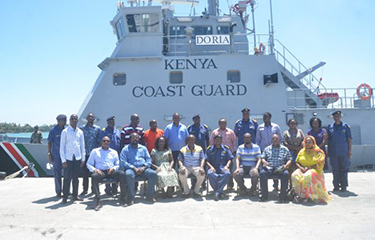Even as landings at Kenya’s second-largest freshwater lake – Lake Naivasha – increased by 188 percent between 2015 and 2019, persistent illegal fishing activities continue to threaten the water body’s potential.
That trend is expected to be reversed after Kenyan government has deployed its Coast Guard and other agencies to tackle the problem of unauthorized fishing operations.
Under an agreement between the national government and the county government of Nakuru – under which Lake Naivasha falls – more patrol officers from the Kenya Maritime Authority and Maritime Police have also been deployed to Lake Naivasha to combat illegal fishing. The officers have also been given orders to support efforts to increase commercial fish production from both the lake and nationally.
“There is a big problem in Lake Naivasha and we are working with other stakeholders to make sure that the law is adhered to,” Kenya Maritime Authority Acting Director-General John Omingo told KBC.
Omingo told Kenya News Agency that the government will “roll out community sensitization meetings towards using proper fishing gear and the importance of abandoning the use of banned fishing gears and methods to reduce pressure on the lake.”
Fish landings at Lake Naivasha increased steadily from 1,072 metric tons (MT) in 2015 to 3,087 MT in 2019. The increase was recorded on 2016 (1,064 MT), 2017 (1,689 MT) and 2018 (2,287 MT), according to Kenya’s 2020 Economic Survey.
Overall, Kenya’s freshwater fish landed in 2019 decreased to 120,900 MT, down from 122,500 MT in 2018. A similar decline was noted in national earnings from freshwater fish landing that dropped to KES 19 billion (USD 173 million, EUR 147 million) last year from KES 21 billion (USD 191 million, EUR 163 million) in 2018.
The illegal fishing in Lake Naivasha has largely involved deployment of banned fishing gear that destroys fish-breeding grounds, especially when some of the poachers carry out their operations within the outlawed 100 meters of the shoreline.
As of 2019, Lake Naivasha was ranked third behind Lake Victoria and Lake Turkana in the total volume of fish landed, after recording 3,087 MT. That’s compared to the 90,743 MT landed in Lake Victoria, and 7,031 MT in lake Turkana.
Except for Lake Victoria, which recorded an 8 percent decline in the amount of fish landed in 2019, all other freshwater fish landing areas posted growth compared to 2018. With the strengthened patrols in Lake Naivasha, the national freshwater fish landings are expected to increase in the short- to medium-term.
Photo courtesy of the Kenyan Coast Guard







